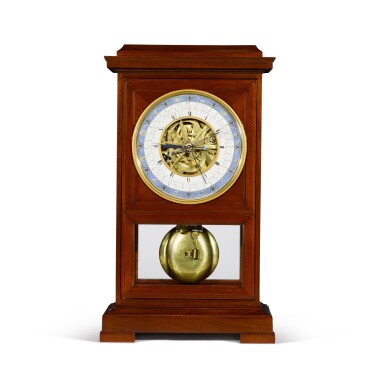Furniture, Clocks & Works of Art
Furniture, Clocks & Works of Art

A Consulate mahogany month-going table regulator with remontoire, equation of time and revolutionary and Gregorian calendars, Jean-Francois Cronier, Paris, dated 1800
Lot Closed
May 18, 02:56 PM GMT
Estimate
40,000 - 60,000 GBP
Lot Details
Description
A Consulate mahogany month-going table regulator with remontoire, equation of time and revolutionary and Gregorian calendars, Jean-Francois Cronier, Paris
dated 1800
7¼-inch annular enamel dial, signed by the enameller Dubuisson A 1800 along the lower edge, the 'jewelled' border decorated with the signs of the Zodiac 'en grisaille', divided by palmettes and gilt scrolls against a pale blue ground, the calendar ring displaying the revolutionary months on the outer edge and the Gregorian months on the inner edge, the open center revealing the equation kidney and the calendar and motion work, plain steel hands for calendar and sweep seconds, pierced steel hand with counterweight for mean time, pierced gilt hand with sun counter weight for solar time and similar gilt hand for the hours, the concealed brass dial plate, signedCronier jeune Eléve de Robin, above the dial and engraved between the winding holes Remontez à Gauche, the movement signed and dated Cronier jne. a Paris 1800, with deadbeat escapement, adjustable steel pallets with long arms and fine depthing screw on the back cock, the escape wheel with very high-count pinion driven by a five-spoke wheel pivoted outside the backplate and mounted with a pulley for the remontoire weight, the weight rewound at frequent intervals by a separate train driven by two spring barrels, the replaced massive gridiron pendulum pendant from a knife-edge fixed to a separately mounted shaped brass bracket, beat adjustment on the crutch, the rectangular moulded case with concealed pin-hole release latches for the doors and glazed on all sides, a degres du cercle block on the interior
52.5cm 20¾in high
Sotheby's London, May 24, 2000, lot 235.
Sotheby's, New York, April 5th, 2004, lot 31.
Jean-François Cronier was apprenticed to Robert Robin (1741 -1799) one of the most brilliant French clockmakers. He then worked with his father Jean-Baptiste-François Cronier at Quai de la Mégisserie, Paris and was made Master in 1787. His father had been made Master in 1781. At this time, Jean-François was known as Cronier Jeune, but after his father's death in 1800 he was called Cronier l'aîné. In 1806 he moved to Place des Trois Maries where he worked until 1820.
Gobin Etienne, known as Dubuisson, worked at Sevres as a flower painter before specialising in watch cases and clock dials, he is recorded as working at various addresses in Paris.
The remontoire, as used on this regulator, is an ingenious device for overcoming the variable driving force provided by spring driven clocks, depending on whether they are fully wound or almost run down. Variation in driving power adversely affects the timekeeping of a spring-driven clock; weight-driven clocks do not suffer in this way and so the remontoire is used to convert a spring driven mantel clock into a weight-driven clock. This is accomplished by using the clock's mainsprings to rewind at frequent intervals, a small weight which acts directly on the escapement. In this way the force of the mainspring has no direct impact on the escapement and so cannot influence the timekeeping.
